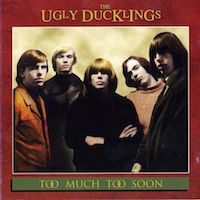Music journalism, books and more
Liner Notes: The Ugly Ducklings – Too Much Too Soon
 On a spring night in 1965, a warm breeze blew along Toronto’s Yorkville Avenue, carrying with it a strange mixture of scents: rich coffee, pungent marijuana and noxious automobile exhaust. Cars crawled along the one-way street between Bay and Avenue Road, past sidewalks filled with teenagers in Beatlecuts and miniskirts. Some sat on café patios, others strolled along the tree-lined boulevard or hung out on doorsteps. Boys watching girls watching boys.
On a spring night in 1965, a warm breeze blew along Toronto’s Yorkville Avenue, carrying with it a strange mixture of scents: rich coffee, pungent marijuana and noxious automobile exhaust. Cars crawled along the one-way street between Bay and Avenue Road, past sidewalks filled with teenagers in Beatlecuts and miniskirts. Some sat on café patios, others strolled along the tree-lined boulevard or hung out on doorsteps. Boys watching girls watching boys.
Like flowers in a hothouse, the musicians in Yorkville thrived on the responses of those who flocked to hear them. There was literally something for everyone: the traditional jazz of Jim McHarg & his Metro Stompers at the Penny Farthing, the delicate ballads of Joni Mitchell at the New Gate of Cleve, the blues folk of John Kay at the Half Beat and the stirring songs of Gordon Lightfoot at the Riverboat.
Meanwhile, the new pop sound had infiltrated the village, with British-influenced bands everywhere: Jack London & the Sparrows at the Café El Patio, Dee & the Yeomen up at the Night Owl and the hard-rocking Ugly Ducklings
over at Charlie Brown’s. Even the venerable Purple Onion had recently switched from folk to feature the blues-rock sound of Luke & the Apostles. The venues were unlicensed, making Yorkville an all-ages haven. Their close proximity meant that club hoppers could catch up to a dozen different acts a night. It also meant that musicians could readily check out what others were playing.
Such was the breeding ground that made Yorkville a cultural crossroads, a musical mecca where guitarists, singers and songwriters from across Canada gathered. With its greasy spoons and crash pads, the village was also a refuge for dropouts and draft dodgers, artists and eccentrics, a place where you could work, love and play outside of the conventions of straight society. The exploding population in Yorkville’s two-block district did not go unnoticed by Toronto’s city fathers. Anxious to clamp down on the burgeoning street culture, city hall began hassling coffeehouse owners with a dizzying array of new by-laws and city ordinances in a desperate bid to control the village’s growth.
Still, Yorkville flourished. At its peak, circa 1966-67, the area boasted more than 40 clubs and coffeehouses. And music continued to pour out of every doorway: the blues rock sound of The Sparrows (later Steppenwolf) at Chez Monique and the fabulous sounds of the village’s most popular group, The Stitch in Tyme, at the Flick. Past the old folks’ home, you’d see the go-go dancer outside the Mynah Bird, which gave Rick James and Neil Young the name of their band. Two of the village’s biggest bands, The Paupers and Kensington Market, both landed U.S. record deals, while The Ugly Ducklings scored a number one hit in 1967 with “Gaslight.”
Before its demise in ’68, with the arrival of bike gangs, hard drugs, sleazy developers and a phony hepatitis scare, Yorkville was Canada’s cultural hotspot, our Greenwich Village or Haight-Ashbury. Long before CanCon, Junos or MuchMusic, Yorkville was the Canadian music scene, the place where all our legends were born.
Abridged from Before the Gold Rush: Flashbacks to the Dawn of the Canadian Sound by Nicholas Jennings, published by Penguin Books.

